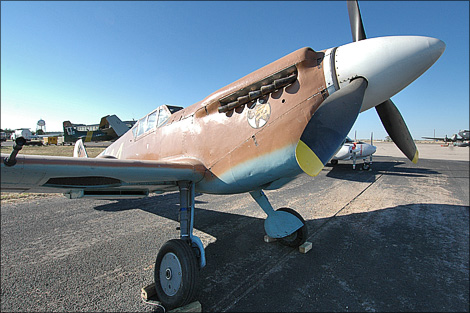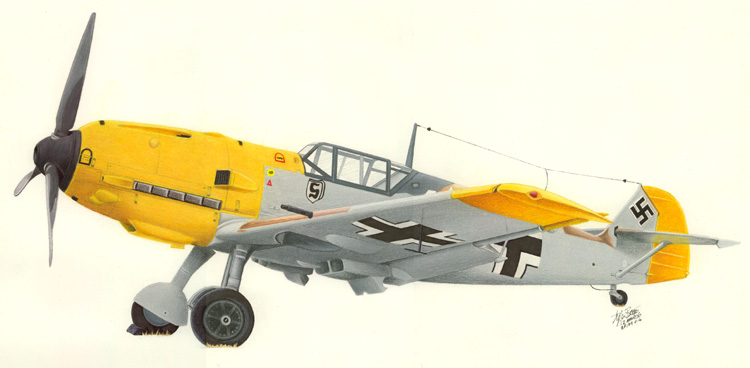|

Hispano HA-1112 Buchon (A Spanish-built, Rolls-Royce Merlin
powered version of the Bf-109)
Photo by Max Haynes -
MaxAir2Air.com
History: In the mid-1930s, the
Luftwaffe began to modernize its fighter aircraft fleet. A competition for new designs was
held, resulting in at least four competitors. Two designs were selected for further
development, one being Willy Messerschmitt's Bf 109, a single-seat derivation of his
previously-successful Bf 108 design. The first -109 prototype, powered by a 695-hp
Rolls-Royce Kestrel engine, first flew on 28 May 1935. The second prototype was fitted
with the engine for which it had been designed, the 610-hp Junkers Jumo 210A.
Pre-production prototypes had various combinations of armament and engines.
The first production model, the Bf 109B-1, was delivered
in early 1937 to the JG132 'Richthofen' squadron, Germany's top fighter unit. The new
fighters quickly established a good combat reputation in the Spanish Civil War later that
year. The next production variant, the Bf 109C-1, appeared in
the fall of 1937, and utilized a more powerful 700-hp Jumo 210Ga engine. Demand for the
airplane was so great that it was built under license by no fewer than four other
companies, including Arado, Erla, Focke-Wolf and Fieseler.
By the time World War II began in 1939, the Luftwaffe had more than 1,000 Bf 109s
in service, and it was to play a major role in all further fighter operations. Allied
bombing gradually slowed German aircraft production, but -109s were also built by WNF in
Austria, and in Hungary. During and after the war, Messerschmitt exported thousands of
Bf-109s to Bulgaria, Finland, Hungary, Japan, Romania, Slovakia, Spain, Switzerland, the
USSR and Yugoslavia. In addition, Spain's Hispano company produced the Bf 109 under
license beginning in 1945, calling it the HA-1109. Their HA-1110
and HA-1112 variants were two-seater and modified single
seaters, respectively. Several engines were fitted, including the 1300-hp Hispano-Suiza
HS-12Z-89 and the 1400-hp Rolls-Royce Merlin 500-45.
Yet another source of Bf 109 production was Czechoslovakia, where the Avia
company supplied S-99 and S-199
variants, many of which remained in service until 1957.
Total production is estimated at 35,000, making it one of the most numerous
aircraft types of the war.
Nicknames: Augsburg Eagle; Buchon
"Pounter Pigeon" (HA-1112); Mezec "Mule" (Avia S-199); Anton
(A-Model); Bertha (B-Model); Clara (C-Model); Dora
(D-Model); Emil (E-Model); Fritz (F-Model); Gustav (G-Model); Beule/Bump
(Bf-109G-1 Trop); Toni (T-Model).
Specifications (Bf-109G-6):
Engine: 1800-hp Daimler-Benz DB-605
inverted V-12 piston engine
Weight: Empty 5,893 lbs., Max Takeoff
6,945 lbs.
Wing Span: 32ft. 6.5in.
Length: 29ft. 7in.
Height: 11ft. 2in.
Performance:
Maximum Speed at
at 23,000 ft: 385mph
Ceiling: 38,500
ft
Range: 450 miles
Armament:
Two 13mm
(0.51-inch) MG131 machine guns
Three 20mm MG151
cannon
Number Built:
~35,000
Number Still Airworthy: ~10 (approximately
two-thirds are HA-112s.)
 [
Bf 109 Pilot Report ] [
Bf 109 Pilot Report ]
 (.PDF document)
(.PDF document)
Hispano HA-1112 Buchon Cockpit Photo:

(Click for larger version)
Links:
Bf109.com -- "A centralized wealth of
information about the Bf 109."
Dakota Messerschmitts --
Full-scale flying replicas.
Falcon's Bf 109 Hangar -- Photos
and information.
It's Russian
Flug Werk, Gammelsdorf, Germany -- Bf 109
parts and restorations.
Hartmair Leichtbau
-- New-built Bf-109s.
Messerschmitt
Bf-109 Cockpit -- Detail photos.
Preserved Axis Aircraft - Bf 109 -- Details about all the -109s still in
existence.
Warbird Recovery -- Colorado,
USA-based organization leading the restoration of two Bf-109s.

[
Click for more
books about the Bf 109!
]

Bf-109 E-4
( Illustration courtesy of
Lyle Brown )

[Back to Warbird Alley's Main
Page]
All text and photos Copyright 2016 The Doublestar Group, unless otherwise noted.
You may use this page for your own, non-commercial reference purposes only.
 |